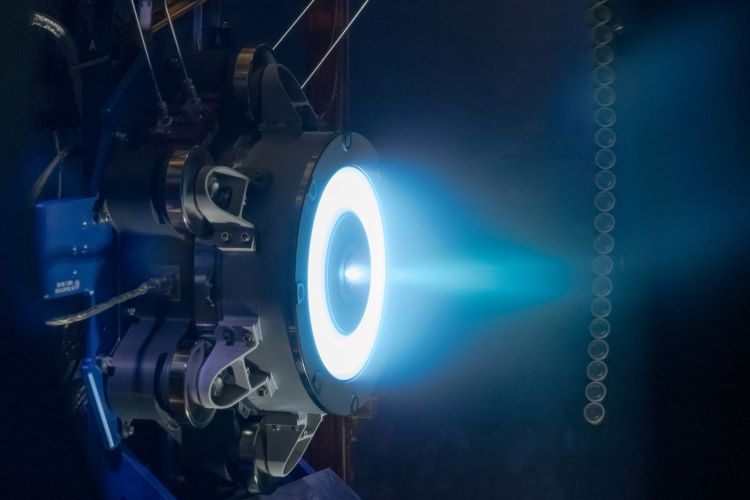The next question comes to mind
is that how would these electric thruster’s work.
An electric thruster (or ionthruster) works by removing the electrons from the propellant atom creating positively charged ions. The most commonly used propella
nt is Xenon because of
its inert nature, high atomic mass, and high storage density which makes it
easy to store in spacecraft. Krypton and Argon are also sometimes used. So,
electrons are bombarded into these propellant atoms, which are neutral, and
remove the electrons from these atoms creating positively charged ions.
 |
| credit: Wikipedia |
Now the gas that is formed after
this bombardment of electrons contains an equal number of negatively charged
electrons as well as positively charged ions, making the overall charge of the
gas neutral. This state of gas is called Plasma. Plasma is a state of matter in
which both positive ions and electrons do not combine and remain separated,
this is also why plasma conducts electricity.
Let’s see how an electric/ion
thruster works. Electric/ion thruster contains a discharge chamber inside of
which propellant (Xenon) is ejected through an inlet. Electrons are produced by
discharge cathode, which produces electrons by a process called thermionic
emission. Thermionic emission is a process in which electrons are released from
the atom by the application of heat.
Walls of the discharge chamber
are electrically charged with high positive potential which attracts the
electrons into the chamber. Propellant
(Xenon), which is neutral, is also supplied inside the chamber. These electrons
then collide with neutral propellant atoms making them lose electrons forming
positive ions. Magnets are installed on the walls of the discharge chamber
which repels the electrons, giving them more time to collide with propellant
atoms forming more ions.
 |
| credit: Wikipedia |
At the end of the discharge
chamber, two grids with thousands of precisely aligned holes are installed. The
inner grid is positively charged and the outer grid is negatively charged. When
electrons come close to the inner grid, they pass through the positively
charged inner grid but are repelled by the outer negatively charged grid.
Positive propellant ions are
repelled by the inner grid but due to high pressure inside of the discharge
chamber, they can pass the inner grid. After that, the negatively charged grid
(also called accelerator grid) accelerates the ions and they are discharged
with very high velocity, 20 – 50 Km/s, which is very high as compared to
chemical rockets (1.7 – 3.2Km/s).
These positive ions which are
expelled out of the discharge chamber with very high velocity produce thrust.
These positively charged ions can again be drawn back towards the spacecraft
which can affect its operations that’s why a neutralizer is installed outside
the discharge chamber which throughs an equal number of electrons to neutralize
the positive ions.
The technology of electric
thrustors may seem like of future but it was first built in 1959 at the NASA
Glenn Research Centre facilities. After that many different types of electric
thrusters are produced and made efficient over time.
Then the question arises as to
why aren’t we using it to propel rockets with this. Well, the thrust produced
by electric thrusters is much less
(25–250 mN). Because of this, they are not powerful enough to take a payload
to space from Earth. They can however be used for several hours as compared to
chemical rockets which are operated for a few minutes. This makes them very
useful to use in minor changes in velocity, orbit, altitude control, etc.
These thrusters have very high
specific impulse also (2000–5000 s), which is the ratio of thrust produced by
the engine to propellant weight flow rate (or mass flow rate). It tells how
efficient our engine is.
